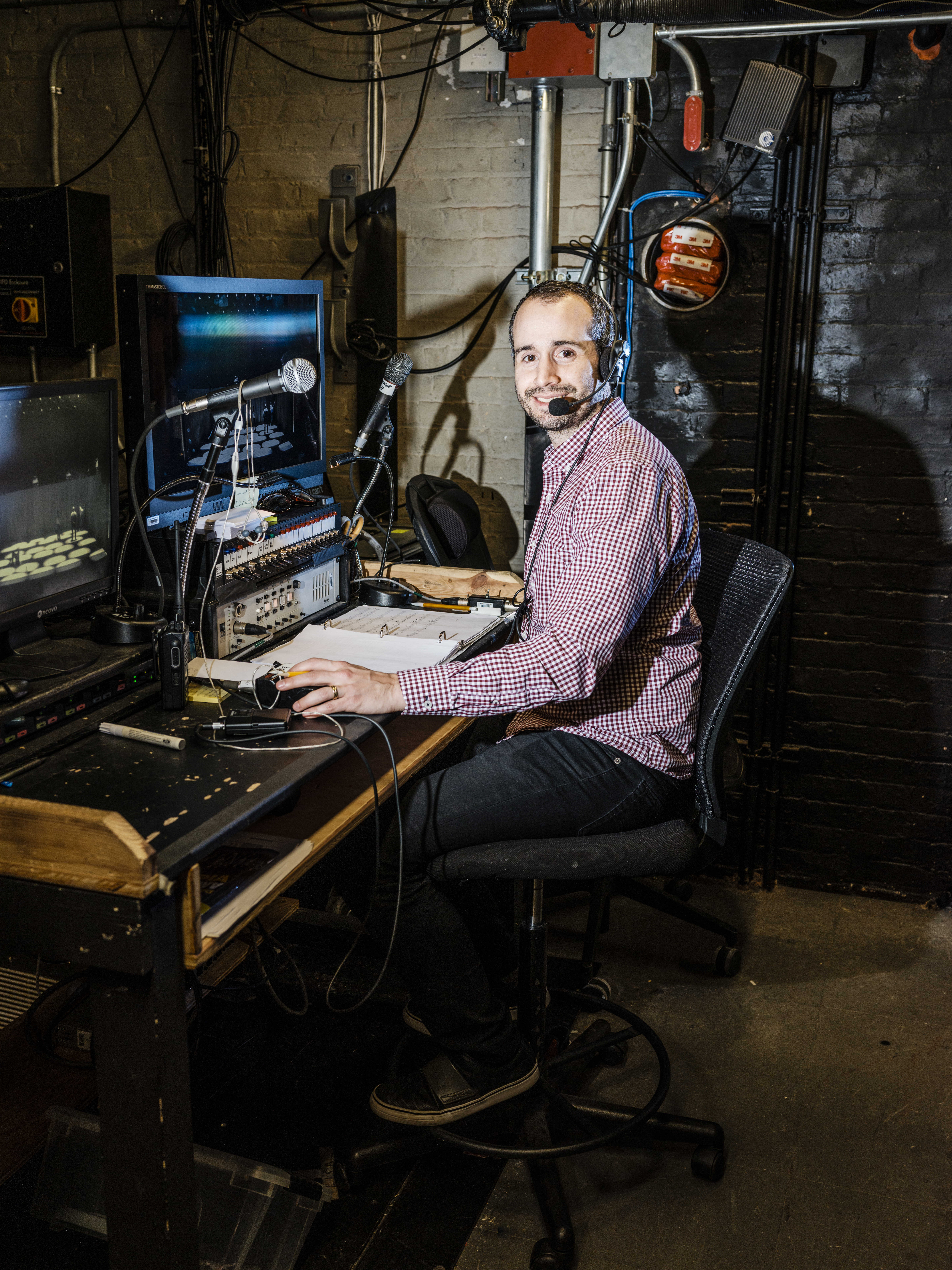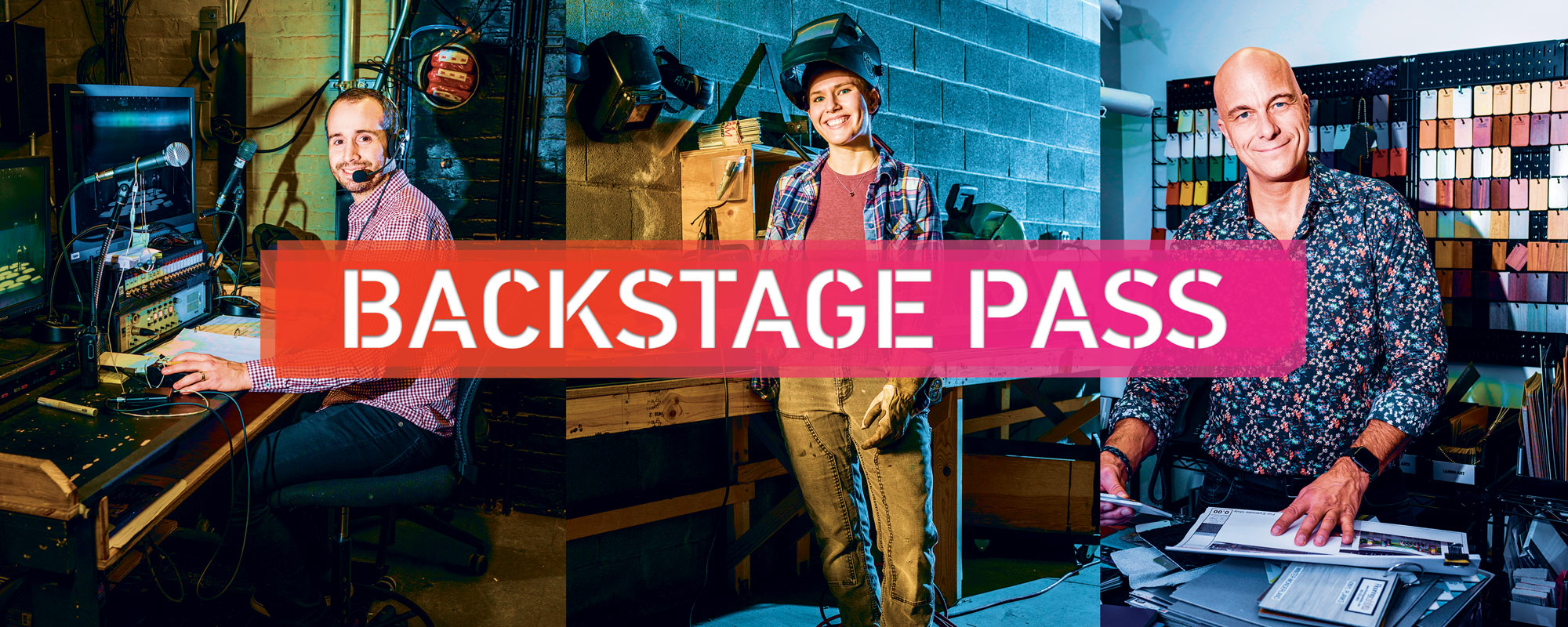Backstage Pass
Design & production alums make shows like Broadway’s Phantom of the Opera and ESPN’s SportsCenter come to life
By Marc Chalufour | Photos by Chris Sorensen
Wrapped around three sides of BU’s Joan & Edgar Booth Theatre in a multi-floored “U” are a series of rooms, both large and small, that comprise the CFA Production Center, where the design & production program makes its home. A massive construction shop, with a ceiling two stories high, gives way—through sliding barn doors—to a paint shop. A motorized dry-cleaner’s rack cycles hundreds of garments around a costume storage space. A room painted black allows students to experiment with lighting techniques. Though the Production Center is new—it opened in 2017—the program dates back to the formation of BU’s School of Theatre in 1954.
“This is our laboratory,” says Joel Brandwine (’01,’21), an assistant professor and head of the technical production program. “This is where students get to apply what they’ve learned in class. If you took scenic design classes, now you’re the scenic designer. If you’re a technical production student, this is your moment to see if you can actually do this.”
Every quarter, the students in the program—91 undergraduates and 41 graduate students in spring 2020—are assigned to a production and spend hours developing their skills behind the scenes in these workshops. “The production management, scenic design, lighting design, costume design, sound design, technical direction—all of that is done by the students,” Brandwine says, listing off the range of degrees offered in the program. “The faculty is strictly here as advisors.”
And all of that experience tends to pay off: “I’ve never had a graduate who wanted to work not get a job,” says Brandwine, himself a graduate of the program with a degree in technical production. Before he returned to teach at CFA in 2011, Brandwine worked on Broadway productions like Jersey Boys and Evita. Alums are currently working in all facets of production for theater, opera, and dance, on Broadway, in regional theaters, and at theater schools. Still others have transferred their skills to television and film.
CFA spoke with three design and production alums to learn more about how they use their training—as a designer, carpenter, and stage manager—to bring a range of shows to life.
Andre Durette (’92)
Flip through the channels on your television and you’re bound to see Andre Durette’s work. ABC, ESPN, Fox, TNT—all have commissioned him to create state-of-the-art sets for their news and talk shows.
Durette (’92) began building sets as a teenager for his high school’s theater program. At BU, he was pursuing a degree in technical production until his professors noticed his talent for design and encouraged him to pursue scene design. “I would get to work on sets that were going into the Huntington Theatre—that was pretty huge,” he says. After working as an off-Broadway designer for a few years following graduation, Durette went back to school to study film and television at NYU. “I like the fact that it’s pretty much a 9-to-5 job, and it pays better than theater does,” he says. He’s been at Jack Morton, an international marketing and events company, ever since. “I’ve always loved theater,” says Durette, a senior design director. “But I ended up loving TV a bit more.”

Despite the transition to the small screen, Durette still finds inspiration on the stage. One idea was sparked by the projected images that bring the set of the Stephen Sondheim musical Sunday in the Park with George to life. Durette adapted that concept for one of his most prominent clients, ESPN. With 10,000 square feet and a budget of approximately $9 million, the 2014 redesign of the network’s SportsCenter set remains one of his biggest projects.
“They do 18 to 20 hours of programming a day in that studio,” he says. “We wanted to make sure that the set could change so you’d have a morning look, an afternoon look, and an evening look.” Inspired by his trip to the theater, Durette designed a wall of monitors positioned at different angles, allowing ESPN producers to display one large or multiple smaller images in a variety of ways. Coupled with illuminated floors and high-tech lighting systems, the screens can be used to transform the set. “We’re constantly trying to come up with something new and innovative to tell a story,” says Durette, who describes himself as part architect, part interior designer. “I’m always thinking about how I’m going to see this through the camera.”
“I’ve always loved theater. BUT I ENDED UP LOVING TV A BIT MORE.”
For another sports set, NBA on TNT, Durette took a very different approach. The Atlanta studio features an open wood floor and arched ceiling reminiscent of a basketball arena. On-screen personalities can move around the space and cameras can shoot them from 360 degrees. “The news is the most important piece, then it’s the talent that’s telling the news,” Durette says. “Then the set is like a character in the background—it’s subtle but also helps to tell the story.” That project won a Sports Emmy for Outstanding Studio Design and Art Direction.
For Durette, the job requires constant innovation. “I always have to be reinventing what TV is,” he says. He’s pioneered touchscreens and recently he’s been experimenting with a screen that folds. “It’s never been done before,” he says. “My clients want the best toys.” Despite the high-tech aspects of his job, Durette finds a simple satisfaction in the results: “It’s nice that I do something that I get to see on TV when I walk into a bar.”
Ana Weiss (’18)
Just off Interstate 95 in Secaucus, N.J., a massive warehouse—bigger than the nearby Home Depot—houses the American Ballet Theatre (ABT). This is where Ana Weiss (’18) spends her time when the company isn’t touring the United States or performing at the Metropolitan Opera House just across the Hudson River in New York City. As one of three carpenters on the ABT crew, Weiss repairs sets, builds replicas for rehearsals, and loads the trucks that carry everything across the country. Among their destinations in 2020, ABT’s 80th season—before postponements due to COVID-19—were California and Washington, D.C., where they performed classics like Giselle, and newer material, including the world premiere of Of Love and Rage.
Weiss wasn’t involved with theater in high school, nor as an undergraduate at the University of Kentucky. Only after graduating with a degree in architecture did she find her way to a summer stock theater on Cape Cod, Mass., where she worked as a carpenter. “Nothing about what I’ve done is a straight path,” she says of her career. While on the Cape, a painter working on the same production talked Weiss into looking at CFA.

“The BU program had an open dynamic for somebody who didn’t already have a theater background,” she says. Weiss took scenic painting and color theory courses and studied fabric dyeing and costume methods as she worked her way toward an MFA in technical production. She wrote her thesis about props. “I wanted to be able to at least know a little bit about every other department,” she says. Those courses filled in her theater experience—and reaffirmed her interests.
“I just like the fun of making things—not necessarily the list-making and the rehearsals and all of that,” she says. And she enjoys the fast pace. “Architecture’s cool. You’re making stuff, you’re designing things, but it can be five or ten years for a project to come along. This could be five or ten weeks.”
The ABT schedule takes up 35 weeks of Weiss’ year, split between travel and time at the warehouse. During ABT’s breaks, she stays busy with freelance gigs like constructing film sets or floats for the Macy’s Thanksgiving Day Parade. On the road, Weiss oversees truck loading and unloading and assembly of ABT’s sets, which has to happen in about a day and a half in each new city. “It’s like a more complicated IKEA,” she says of the load-in process. During shows, she’s in charge of stage left, managing set changes between scenes. For some shows, she says, it’s an easy job—The Nutcracker unfolds in front of a simple door—while others provide a complex challenge. Swan Lake shifts from a ballroom to a forest, a changeover that happens in about 90 seconds. But, Weiss says, “We haven’t ever had to hold the curtain for a scene change.”
Get a behind the scene’s look at the American Ballet Theatre’s 2017 production of Swan Lake. Video courtesy of the American Ballet Theatre.
Greg Livoti (’05)
When Greg Livoti (’05) arrived at CFA to study stage management, he was surprised to find a list of art supplies rather than books on his first course syllabus. “It was a shock when I learned I was going to be hand drafting and sewing. I’m not an artistic or design-oriented person,” he says. “But the more I worked, the more I could see how I drew upon those basic foundations.”
When Livoti describes his current work—he’s been the production stage manager for Phantom of the Opera since 2014 and recently took a five-month break to serve the same role with David Byrne’s American Utopia—he compares it to air traffic control. His work typically starts in the afternoon, making sure there are no gaps in that evening’s cast, then communicating any personnel changes to the hair, wardrobe, and makeup departments. Once the curtain rises, Livoti is either calling out lighting cues or taking notes on the performance that he’ll share with creative and technical staff the following day—which could range from a performer standing slightly off his mark or a costume that needs repair. Livoti also maintains calendars for the production, scheduling rehearsal time, working new cast members into the show, and making sure that the team is always ready for the next performance.

Phantom of the Opera, which opened in New York in 1988, is the longest-running Broadway show in history, and the job of maintaining consistency falls to Livoti and his three-person team. “We’re responsible for facilitating communication between everyone,” he says. “It’s our job to make sure that the artistic intentions of the creative team in performance number one are still playing true in performance 248 or 2,448 or 10,448,” Livoti says. “It takes over 100 human beings to do Phantom of the Opera every night, and I have weekly conversations involving every department. It’s very much a collaborative effort.”
Livoti reflects on how his time as a stage manager at CFA prepared him for his responsibilities today. At BU, he participated in a weekly colloquium where all of the stage managers would gather and discuss the shows they were working on. “We would work on four shows a year,” he says, but because of those conversations, “it was like working on 16, because you heard all of the nitty-gritty details.”
Livoti estimates that he’s now worked more than 2,000 performances of Phantom of the Opera. “I can experience what the audience is experiencing. I can feel when moments of impact land, whether they’re emotional or comedic,” Livoti says. “There’s just something about being able to tell a story to hundreds of strangers and to know that if I’m doing my job correctly, that story is being told the way that it’s intended to be told.”
Greg Livoti (’05) has been the production stage manager for the Phantom of the Opera, Broadway’s longest-running show, since 2014. Watch Phantom cast members perform the musical’s hit song “The Music of the Night.” Video courtesy of the Phantom of the Opera.










